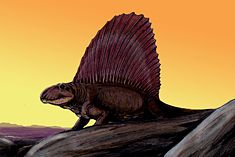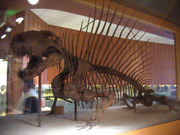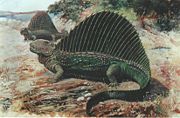Dimetrodon
2008/9 Schools Wikipedia Selection. Related subjects: Dinosaurs
| Dimetrodon Fossil range: Early-Middle Permian |
||||||||||||||||
|---|---|---|---|---|---|---|---|---|---|---|---|---|---|---|---|---|
 Restoration of Dimetrodon
|
||||||||||||||||
| Scientific classification | ||||||||||||||||
|
||||||||||||||||
| Species | ||||||||||||||||
|
Dimetrodon (pronounced /daɪˈmɛ.tɹəʊˌdɒn/, meaning "two measures of teeth") was a predatory synapsid (' mammal-like reptile') genus that flourished during the Permian Period, living between 280 - 265 million years ago. It was more closely related to mammals than to true reptiles such as dinosaurs and lizards.
Dimetrodon was not a dinosaur, despite being popularly grouped with them. Rather, it is classified as a pelycosaur. Fossils of Dimetrodon have been found in North America and Europe, as well as a significant discovery of Dimetrodon footprints in southern New Mexico by Jerry MacDonald. The climate of Europe and North America in the Early Permian, was probably arid to continental, so Dimetrodon was probably adaptable.
Description
Dimetrodon was an apex predator, among the largest of its day. It grew to up to 3 1/2 meters (11 feet) in length. The name Dimetrodon means 'two-measures of teeth', so named because it had a large skull with two different types of teeth (shearing teeth and sharp canine teeth), unlike reptiles. Dentition showing this differentiation of teeth is called heterodonty. It walked on four side-sprawling legs and had a large tail. Dimetrodon may have moved in a manner similar to present-day lizards.
Sail
The most distinctive characteristic of Dimetrodon was the spectacular sail on its back (other pelycosaurs such as Edaphosaurus, Ianthasaurus, and Sphenacodon also have this trait). The sail, which was dense with blood vessels, was probably used to regulate body temperature; the surface area would allow it to warm up or cool off more efficiently. This adaptation was important because it would give the animal more time to hunt prey. The sail may also have been used in mating rituals and to warn off other predators. The sail was supported by neural spines, each one sprouting from an individual vertebra. Bramwell and Fellgett (1973) calculate that a 200 kg Dimetrodon would heat up from 26° C to 32° C in 205 minutes without a sail and in only 80 minutes with a sail.
Relationship with modern mammals
As a synapsid, Dimetrodon was distantly related to modern mammals. Synapsids were the first tetrapods to evolve differentiated (or heterodont) teeth. Whereas reptiles hardly chew their food, simply gulping it down, synapsids like Dimetrodon developed teeth to help shear meat into smaller pieces for easier ingestion. These 'two-measure teeth' eventually gave rise to the various kinds of teeth present in modern mammals.
In popular culture
In many popular culture references, Dimetrodon is often erroneously seen as a dinosaur or as living alongside dinosaurs.
A composite of Edaphosaurus and Dimetrodon fossils went on display in 1907 in the American Museum of Natural History, New York, presented by the curator of vertebrate paleontology Henry Fairfield Osborn and illustrated in the pages of Scientific American (May 1907) as "Naosaurus", by the great scientific illustrator Charles R. Knight.
In the television documentary Walking With Monsters (called Before the Dinosaurs in the U.S.), baby Dimetrodon were shown hatching with sails, fully independent. In fact, no Dimetrodon eggs have yet been found and it's entirely possible that the sail, which would be hard to store in an egg, was either absent or not rigid upon hatching. Hatchlings were portrayed sprinting towards trees after hatching in order to escape cannibalistic adults, behaviors based on the modern Komodo Dragon. Dimetrodon was also shown as having an egg-laying style similar to the modern crocodile, though no evidence regarding Dimetrodon reproduction has ever actually been found.
Dimetrodon was one of several prehistoric animals seen in the Rite of Spring segment of Disney's Fantasia, where it is shown as an intermediate predator, preying upon Nothosaurus but fleeing from a Tyrannosaurus.


